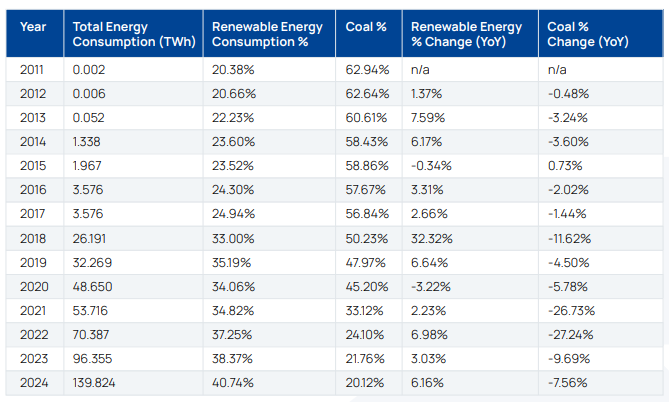Bitcoin mining has seen a significant decrease in its reliance on coal over the past decade, according to a new report released on March 31st by the MiCA Crypto Alliance, in partnership with risk data platform Nodiens.
The report shows that the share of coal energy used in Bitcoin mining has dropped from 63% in 2011 to just 20% in 2024, representing a 43% decline over 13 years. This equates to an average annual reduction of approximately 8% in coal dependency.
At the same time, the use of renewable energy sources has increased at a steady pace—growing by an average of 5.8% per year. The trend suggests a clear transition toward cleaner energy within the Bitcoin mining ecosystem.

The shift toward renewables in Bitcoin mining stands in stark contrast to broader global energy trends. According to a 2024 report by the International Energy Agency (IEA), global coal use surged to an all-time high of 8.8 billion tonnes last year.
The IEA forecasts that global coal demand will remain near record levels through 2027, driven by growing consumption in emerging economies such as India, Indonesia, and Vietnam.
Against this backdrop, Bitcoin’s changing energy profile could help combat perceptions that the cryptocurrency is a net contributor to environmental degradation.
Scenarios for Bitcoin’s Energy Use Through 2030
Looking ahead, the MiCA-Nodiens report outlines five future scenarios based on projected Bitcoin prices ranging from $10,000 to $1 million per BTC. Each price level corresponds with different levels of mining activity and energy consumption, allowing for a range of environmental outcomes.

In the “medium price” scenario of $250,000 per BTC, the report estimates that renewable energy (excluding nuclear) could make up between 59.3% and 74.3% of Bitcoin’s total energy use, depending on future policy conditions.
The report also forecasts that Bitcoin mining’s energy consumption will peak around 2030, a finding that mirrors projections made in a 2021 study by NYDIG. That study estimated that even under bullish price conditions, Bitcoin’s energy usage would only reach 0.4% of global primary energy consumption and 2% of total electricity generation.
A Sustainable Future for Bitcoin?
While concerns about Bitcoin’s environmental impact remain, the data paints a more optimistic picture. A continued shift away from coal and toward renewables suggests that mining can evolve alongside global decarbonization efforts, especially as miners seek out cheaper, greener energy to remain competitive.
The report’s findings signal that policy, price, and technology will all play crucial roles in shaping Bitcoin’s long-term sustainability and that the next decade may be pivotal in defining how crypto fits into the world’s clean energy transition.





